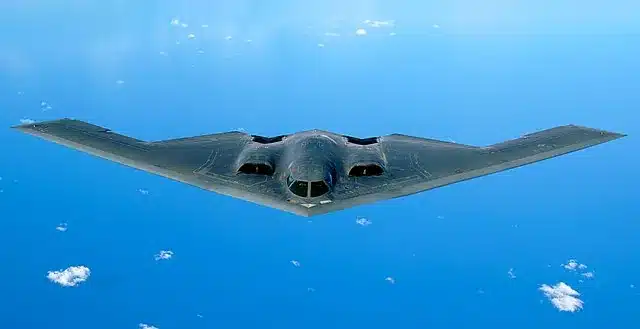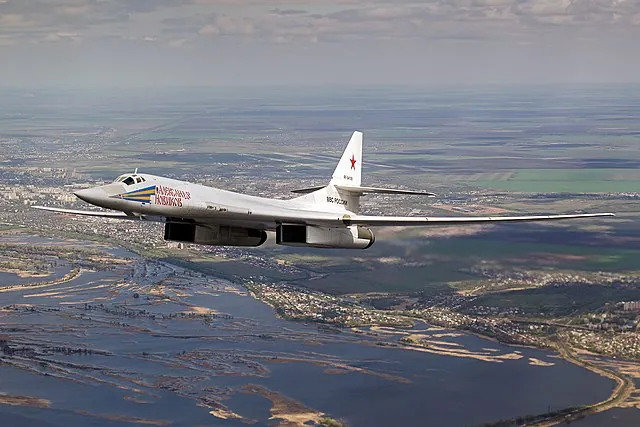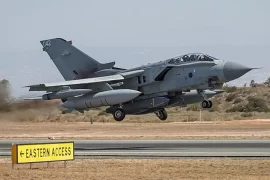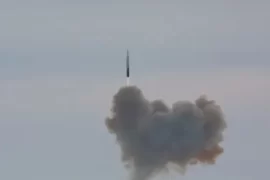In the realm of military aviation, the bomber has long been a symbol of strategic power projection and deterrence. These formidable aircraft serve as the backbone of any nation’s defense strategy, capable of carrying out precision strikes, long-range missions, and nuclear deterrence. Among the numerous bombers that have taken to the skies, five stand out as the most powerful and iconic examples of aerial might. This article will delve into various features of these bombers.
List of the world’s 5 most powerful bombers
The world’s 5 most powerful bombers are the Northrop Grumman B-2 Spirit, Tupolev Tu-160, Rockwell B-1B Lancer, Boeing B-52H Stratofortress, and Tupolev Tu-95.
Northrop Grumman B-2 Spirit (USA), the most powerful bomber
Manufacturer: Northrop Grumman
First flight: 17 July 1989
Introduction: 1 January 1997
Status: In service
Primary user: United States Air Force
The Northrop Grumman B-2 Spirit is the most powerful bomber in the world. It is a sleek and sinister creation resembling a bat in flight. It holds a unique role in the arsenal of US military might. Revered as the “silver bullet” of American policy, the top strategic bomber in the world remains reserved for the most critical targets. Conceived during the Cold War, its development was shrouded in utmost secrecy.
Remarkably, the B-2 Spirit carries the title of the most expensive aircraft ever built. With a mere 20 in the possession of the US Air Force due to its exorbitant cost, this advanced marvel has never been offered for sale, even to trusted NATO allies.
Its design, adorned with a radar-absorbent coating, renders it nearly invisible to enemy radar systems, enabling it to infiltrate hostile territories without detection. Concealed behind classified sensors and avionics, it boasts an undisclosed electronic warfare system.
Armed with a formidable arsenal, the B-2 can carry up to 18,000 kg of weaponry, spanning cruise missiles, precision-guided bombs, and even thermonuclear free-fall bombs. What’s more, its astonishing range of over 12,000 km allows it to traverse vast distances without refueling.
Despite its unparalleled capabilities, the B-2 Spirit’s reign as the premier operational bomber faces a new dawn with the emergence of the B-21 Raider. This successor, unveiled in 2022 by the US Air Force, shares the B-2’s sleek outline but represents an entirely new iteration. Anticipation surrounds its initial operating capability, expected to unfold in the coming years, ushering in a new era of airborne dominance.
Tupolev Tu-160 (Russia), the 3rd most powerful bomber
Manufacturer: Kazan Aircraft Production Association
First flight: 18 December 1981
Introduction: April, 1987
Status: In service
Primary user: Russian Aerospace Forces
The Tupolev Tu-160 is the most powerful Russian bomber. The bomber, known as the “White Swan” in Russia and Blackjack in NATO designation, emerged from the Cold War era as a symbol of Russian strategic prowess. Designed to target vital American assets, this colossal strategic bomber dwarfs its resembling counterpart, the B-1B Lancer, holding the distinction of being the largest and heaviest combat aircraft ever constructed.
The Tu-160’s formidable payload includes cruise and land attack missiles, equipped for both conventional and nuclear payloads. This versatile bomber is capable of carrying free-fall bombs weighing up to 40 tons, providing flexibility in its mission capabilities, all while boasting a remarkable range of 14,500 km.
Production of the Tu-160 was relatively limited, yielding an estimated 39 aircraft due to its high costs of construction and maintenance. By 2017, Russia retained around 16 operational bombers, with only 10 confirmed airworthy in 2022 based on satellite imagery.
In a recent development, Russia rekindled the production of the Tu-160 bombers. The inaugural flight of a newly-built and modernized Tu-160 in 2022 marked a renewed chapter for this iconic aircraft, underscoring its enduring significance in Russia’s strategic arsenal.
Rockwell B-1B Lancer (USA)
Manufacturer: North American Rockwell/Rockwell International
First flight: 23 December 1974
Introduction: 1 October 1986
Status: In service
Primary user: United States Air Force
The Rockwell B-1B Lancer, a strategic bomber introduced in 1986 during the Cold War, stands as a testament to American ingenuity. It is often referred to simply as the “Bone”. Originally conceived as a successor to the B-52, the Lancer also took on the vital role of carrying nuclear weapons. Infused with a degree of stealthiness, it is fortified with advanced countermeasures to thwart sophisticated enemy air defenses.
With an internal capacity to carry a staggering 34,000 kg of missiles or bombs, the B-1B surpasses all other US bombers in payload capability. Initially designed for nuclear strike missions, the post-Cold War era led to a transformation, repositioning the Lancer for conventional warfare roles.
The production run yielded 100 B-1Bs, and approximately 70 remain operational at any given time. Foreseeing its role in the future, it is anticipated that the B-1B will serve until at least 2030 when it will be succeeded by the next generation of bombers. A symbol of American air power, the B-1B Lancer’s enduring service underscores its pivotal contribution to the nation’s strategic capabilities.
Boeing B-52H Stratofortress (USA)
Manufacturer: Boeing
First flight: 15 April 1952
Introduction: February 1955
Status: In service
Primary user: United States Air Force , NASA
The Boeing B-52H Stratofortress, an icon of American military might, epitomizes endurance and adaptability. Designed initially to carry nuclear armaments, it has been a stalwart of the US Air Force since 1955. The lineage encompasses a total of 744 B-52 strategic bombers, with the B-52H representing the pinnacle of its evolution. Through consistent upgrades, it has maintained its relevance, outlasting newer counterparts.
Surpassing the introduction of contemporary aircraft, the B-52’s exceptional performance and cost efficiency have preserved its active status. Presently, 85 of these bombers remain in service, a testament to their enduring value. Projected to serve until 2044, the B-52 is poised to continue its vital role well into the 21st century.
Despite its long history, the B-52’s combat legacy involves only conventional munitions, employed in various conflicts. Armed with the capacity to carry 32,000 kg of weaponry, including cruise missiles and precision-guided bombs, its reach extends over 18,500 km without refueling. With its unmatched endurance, adaptability, and indomitable service record, the Boeing B-52H Stratofortress retains its position as an essential element of American air power.
Tupolev Tu-95 (Russia), the 5th most powerful bomber
Manufacturer: Aviakor
First flight: 12 November 1952
Introduction: 1956
Status: In service
Primary user: Russian Aerospace Forces
The Tupolev Tu-95, renowned as the Bear in NATO classification, has carved an enduring legacy in Russia’s long-range air capabilities. Commissioned in 1956, this turboprop-powered strategic bomber was originally devised to carry nuclear payloads to American soil. With an impressive capacity of approximately 15,000 kg, it wielded formidable destructive potential.
Evolution has seen updated iterations of the Bear, equipped with six long-range cruise missiles, enhancing its combat versatility. Boasting an unrefueled range of approximately 12,500 km, later variants have pushed this range to 15,000 km.
Amassing a fleet exceeding 500 aircraft, the contemporary bomber/missile carrier model, the Tu-95MS, emerged in 1984 and continued production until 1992. Currently, around 60 Tu-95MS aircraft stand in service within the Russian Air Force. As the sole turboprop-powered strategic bomber in operation, the Bear defies age, poised to endure until at least 2040. Through decades of service, the Tupolev Tu-95 stands as a testament to Russia’s enduring commitment to formidable long-range air power.
Summary of the world’s 5 most powerful bombers
The world’s 5 most powerful bombers in 2024 are:
- Northrop Grumman B-2 Spirit
- Tupolev Tu-160
- Rockwell B-1B Lancer
- Boeing B-52H Stratofortress
- Tupolev Tu-95.
In conclusion, the world’s most powerful bombers represent not only technological achievements but also the strategic thinking and geopolitical considerations of the nations that employ them. From the stealthy and elusive B-2 Spirit to the enduring Tu-95, these aircraft embody the ability to project force across vast distances. They can shape the dynamics of modern warfare and global security. As geopolitical landscapes evolve, these powerful bombers serve as a reminder of the delicate balance of power in the skies.
Sources:
- Reuters, US Air Force’s new B-21 Raider “flying wing” bomber takes first flight, Novermber 12, 2023
- Taas, Russia’s upgraded Tu-95 strategic bomber to make debut flight by late August, August 3, 2020













“Concealed behind classified sensors and avionics, it boasts an undisclosed electronic warfare system”
I’m at a loss to understand how you can “boast” about something you’re not prepared to disclose